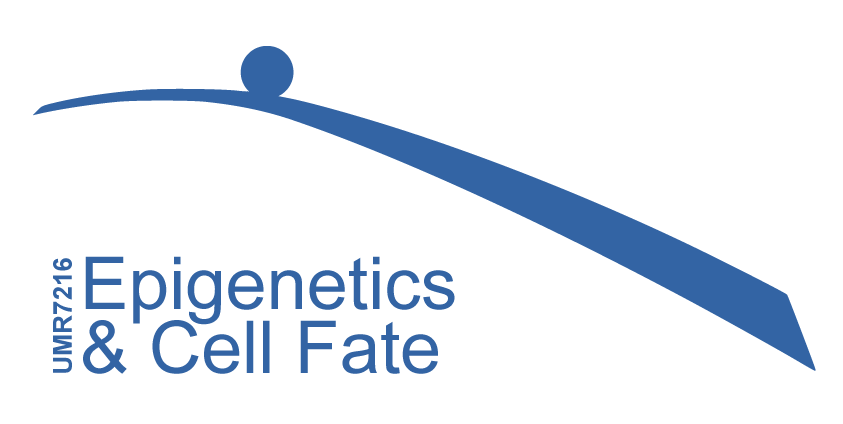Céline is a permanent researcher (CR1) with the INSERM. She did her Ph.D. in the Mouse Molecular Genetics Unit at the Pasteur Institute, on the characterization of genomic elements involved in the initiation step of random X-chromosome inactivation using targeted mutagenesis in mouse embryonic stem (ES) cells. Then she did a three-year postdoctoral training in Wendy Bickmore’s lab in Edinburgh where she studied the nuclear re-organization associated with the activation of Hox gene clusters during mouse development using 3-dimensional fluorescence in situ hybridization techniques (3D FISH).
She joined Claire Rougeulle\\\’s lab in the fall of 2014. Her current project is to characterize the role of the Ftx lncRNA during mouse development.
SELECTED PUBLICATIONS
- Morey C., Rougeulle C. & Ouimette JF. Unleashing XIST from X-chromosome inactivation. Current Opinion in Cell Biology, 2024 November
- Altered X-chromosome inactivation predisposes to autoimmunity . Science Advances, 2024 May
- Furlan G, Gutierrez Hernandez N, Huret C, Galupa R, van Bemmel JG, Romito A, Heard E, Morey C, Rougeulle C. The Ftx Noncoding Locus Controls X Chromosome Inactivation Independently of Its RNA Products. Mol Cell. 2018 Apr 20.
- Prudhomme J., Morey C. Epigenesis and plasticity of mouse trophoblast stem cells. Cell Mol Life Sci. (2016) Feb;73(4):757-74.
- Prudhomme J, Dubois A, Navarro P, Arnaud D, Avner P, Morey C. A rapid passage through a two-active-X-chromosome state accompanies the switch of imprinted X-inactivation patterns in mouse trophoblast stem cells. Epigenetics Chromatin. (2015) 1;8:52.
- Deuve JL, Bonnet-Garnier A, Beaujean N, Avner P, Morey C. Antagonist Xist and Tsix co-transcription during mouse oogenesis and maternal Xist expression during pre-implantation development calls into question the nature of the maternal imprint on the X chromosome. (2015) Epigenetics.10:931-42.
- Merzouk S, Deuve JL, Dubois A, Navarro P, Avner P, Morey C. Lineage-specific regulation of imprinted X inactivation in extraembryonic endoderm stem cells. (2014) Epigenetics Chromatin. 7:11.
- Dubois A, Deuve JL, Navarro P, Merzouk S, Commere PH, Louise A, Arnaud D, Avner P, Morey C. Spontaneous reactivation of clusters of X-linked genes is associated with the plasticity of imprinted X-inactivation in mouse trophoblast stem cells. (2014) Stem Cells. 32(2): 377-90.
- Morey C, Avner P. The Demoiselle of X-inactivation: 50-year old and as trendy and mesmerising as ever. (2011) PLoS Genet. 7(7) : e1002212. Morey C, Avner P. Genetics and Epigenetics of the X Chromosome. (2010) Ann N Y Acad Sci. 1214: E18-33.
- Morey C, Kress C, Bickmore W. Lack of bystander activation shows that localization exterior to chromosome territories is not sufficient to upregulate gene expression. Genome Res. 19: 1184-1194
- Morey C, Da Silva N, Kmita M, Duboule D, Bickmore W. Ectopic nuclear reorganisation driven by a Hoxb1 transgene transposed into Hoxd. (2008) J Cell Sci. 121 : 571-577.
- Morey C, Da Silva N, Perry P, Bickmore W. Nuclear re-organisation and chromatin decondensation are conserved, but distinct, mechanisms linked to Hox gene activation. (2007) Development. 134: 909-919.
- Morey C, Navarro P, Debrand E, Avner P, Rougeulle C, Clerc P. The region 3’ to Xist mediates X chromosome counting and H3 Lys-4 dimethylation within the Xist gene. (2004) EMBO J. 23: 594-604.
- Morey C, Arnaud D, Avner P, Clerc P. Tsix-mediated repression of Xist accumulation is not sufficient for normal random X-inactivation. (2001) Hum Mol Genet. 10: 1403-1411.

